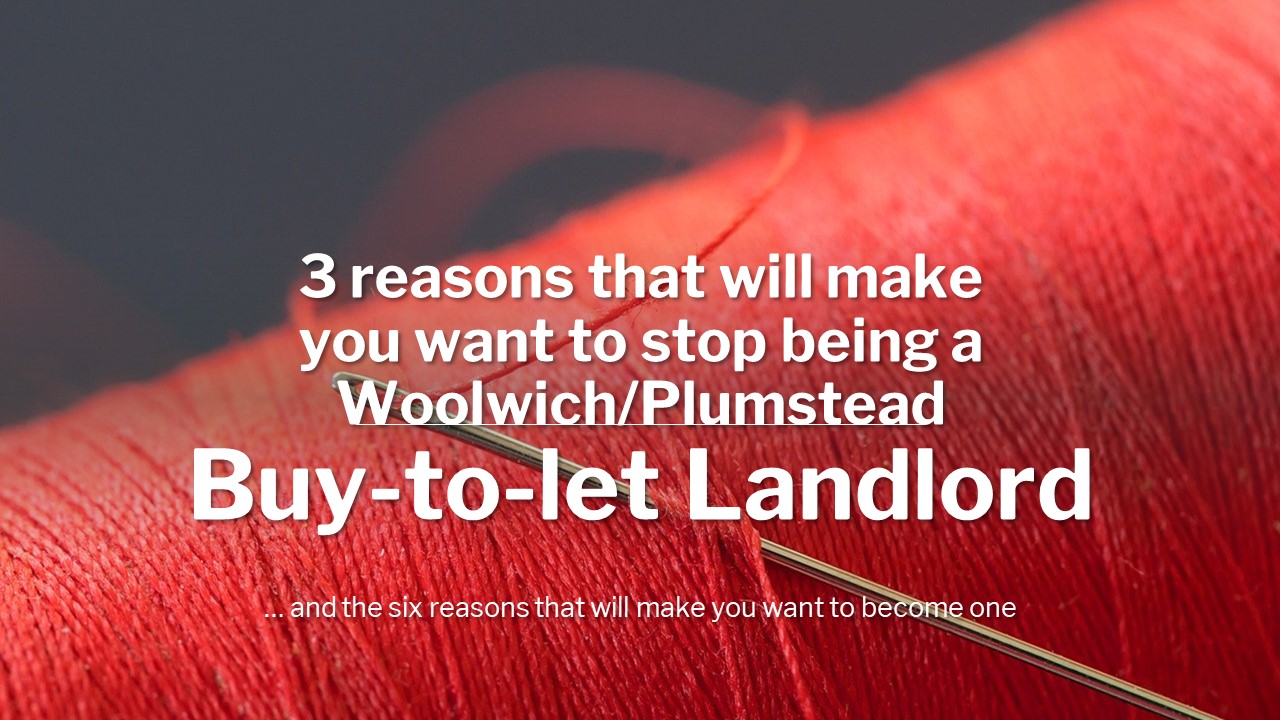The buy-to-let market in Plumstead and Woolwich is about to enter a challenging 12 to 24 months. Yet by looking back at the last recession and what is happening now, there are vital lessons all Plumstead and Woolwich landlords can learn to protect themselves, and in fact create opportunities for themselves both in the short term and ultimately the longer term. For the purposes of this article, I would like to split these and look at the challenges and then the opportunities.
So, let’s consider the challenges ahead for Plumstead and Woolwich landlords …
Overall, the impending rise in unemployment stands to encumber tenants’ ability to pay their rent, the rents being achieved and the possible Capital Gains Tax changes might mean an increase in tax paid by Plumstead and Woolwich landlords when they come to sell their buy-to-let properties.
Lets look at these three points in greater detail. Firstly looking at your Plumstead or Woolwich tenants ability to pay the rent; the Furlough Scheme certainly did help soften the blow, helping out 8.9 million people in May (out of 30.5 million who were eligible for it) and at the last count in early August, this thankfully had reduced to 5.3 million people (meaning 15.86% of workers are still on furlough). However, it cannot be denied the economic fallout from Coronavirus has already placed some tenants under economic strain. As the Furlough Scheme finishes at the end of October, commentators are suggesting the number of tenants either incapable of paying their rent, or requesting a reduction in their rent, is predicted to increase as we go into autumn and early winter.
The ultimate sanction against non-payment of rent is legal proceedings although guidance from the Government has recommended that landlords and tenants should work together and deplete all possible options before starting eviction proceedings. Yet many Plumstead and Woolwich landlords are feeling the pressure as many mortgage payment holidays will be coming to a close at the end of September. Some Plumstead and Woolwich landlords can indisputably see that their tenants are finding it tough and they are willing to work with them, but they can only make allowances go so far. Landlords aren’t running a charity and I would stress to any tenant that finds themselves being made unemployed in the months to come to apply for Universal Credit as soon as possible, which should help with their rental payments. With regard to the eviction process, the Government have changed the rules a number of times in the last few months, so if you want an update, don’t hesitate to contact me, whether you are client or not – I am just happy to help.
Secondly, it’s interesting that in central London, there has been a glut of Airbnb properties coming onto the market because of lack of tourists to rent them on a short-term let. A greater supply of rental properties has meant a downward pressure on rents in London of 2.1%.
Thirdly, there is talk that the Chancellor, Rishi Sunak, is looking at changing the Capital Gains Taxation rules. As property is the biggest asset that most people own, this is also reason for concern for Plumstead and Woolwich buy-to-let landlords. Currently, Capital Gains Tax on sales of buy-to-let property is levied at 18% for basic income tax rate payers and 28% for higher rate income taxpayers. There is talk the capital gains made on the landlord selling their buy-to-let property could be taxed at the landlord’s income tax rate.
Yet before you all start selling your Plumstead or Woolwich portfolios before November’s budget, any changes in Capital Gains Tax would be immediate. That means to ensure you didn’t come foul of the potential rise in the tax, you would have to have to sell your Plumstead or Woolwich portfolio at a ‘fire sale price’ in days and have a solicitor that could do the conveyancing in 3 weeks (whilst it is taking 19 weeks on average for buyers to sort their legal work out) and the buyer be a cash buyer because banks are taking months, not weeks to sort finance. This is just something we are going to have to take on the chin!
Let us now consider the opportunities ahead for you Plumstead and Woolwich landlords …
As the country officially entered its first recession since 2009, uncertainty in any markets (be it property or stocks and shares etc.) causes investors to vacillate over whether or not to take the jump. Nevertheless, there are numerous indicators that appear to show this is, indeed, a good time either to become a buy-to-let Plumstead or Woolwich landlord or expand one’s property empire and buy more property … let me explain.
Firstly, assets (such as gold and stocks and shares) are great, yet if they aren’t producing income and cash – that doesn’t pay for your day-to-day living. Gold doesn’t create any income and many FTSE companies won’t be paying dividends for a while. Government Bonds are currently earning their investors 0.2% (no – that isn’t a typo) and the best savings accounts are achieving 1.1% with a 120-day notice period, so where are you going to invest your hard-earned money?
The average Plumstead and Woolwich (SE18) buy-to-let property will earn a monthly return of 5.11%
Of course, deciding on the right Plumstead or Woolwich property is crucial to get a good rental income and return. I have seen so many Plumstead and Woolwich first-time landlords buy with their heart and not their head. Buying your own home is more heart than head but buy-to-let is a completely different kettle of fish. There is the inverse relationship between income (rent) and capital growth (how much it will go up in value in the future) i.e. as one goes up, the other tends to go down – so getting the balance for your needs is vital. Again, I can advise on that for you.
Secondly, with the stamp duty holiday and the pent up demand for people wanting to move home in Plumstead and Woolwich (discussed many times recently in this blog), the Plumstead and Woolwich property market is certainly very buoyant at the moment, yet even the most optimistic agents say it cannot last. Whether the market goes pop or has a slow and steady puncture, the market will cool in 2021. The recession will mean some people are less able to afford a mortgage. This means that if Plumstead and Woolwich property values do ease off in 2021, you may be able to get a great buy-to-let deal if you are planning on becoming a Plumstead or Woolwich landlord or expand your property empire as an existing landlord.
Also, if the property market does find property prices realign to a new normal in 2021/2, house sellers may find it difficult to get a good price on their Plumstead or Woolwich home during a recession, meaning many house sellers may be more agreeable to sell their property at a lower price.
Third, if people aren’t buying, they still need a roof over their head and the council aren’t building any council houses, meaning the private sector will need to take up the slack.
Rightmove reported tenant demand grew by a third in mMay 2020 when compared to the same month in 2019
Therefore, if you are still unsure about becoming a Plumstead or Woolwich landlord, knowing that more Plumstead and Woolwich people want to rent should help you feel more comfortable as the risk of ‘running out’ of renters interested in your property is minimal. Yet again, please don’t go buying any old Plumstead or Woolwich property, as it’s fundamental that you make a good investment from the start in order to see a good return on your investment.
If Plumstead and Woolwich property values do fall in 2021 (as in 2009), tenant demand for Plumstead and Woolwich property will only go up
Fourth, the Government reduced Stamp Duty with the sole aim to benefit the property market. The purchase needs to complete by the end of March 2021, which means you will need to have bought the property by November at the latest (as obtaining finance and legal work is taking at least 19 weeks). A word to the wise though, that whilst the saving in Stamp Duty delivers some up-front saving for those buying a buy a let property, don’t get carried away and use that saving in the purchase price you pay. Certain sectors of the Plumstead and Woolwich property market are seeing some very inflated prices, meaning if you go into battle for a show home quality semi-detached house within a stone’s throw of the best school, you will be fighting against buyers who want it for themselves and are prepared to pay top dollar for it, meaning some landlords could end up paying more for a property. My advice, if you want to save on the Stamp Duty, there are bargains to be had – you just have to know what you are looking for (again, as mentioned in point 1 – I am here to help on that whether you are a client of mine or not). The other option would be ‘just hold back’ until after 31 March 2021, when Plumstead and Woolwich property prices could ease.
Fifth, reports that the mortgage lenders are imposing stricter conditions are true, yet even during Covid, many lenders are seeing buy-to-let landlords as a safer option to lend their money to. In June alone, the number of buy-to-let mortgage products rose by 19.2% (to just over 1,700) meaning if you have a decent deposit of 30% upwards, you are likely to find something that fits your needs (at the time of writing this article, the Birmingham Midshires had a buy-to-let 5-year fixed rate mortgage at 1.94% and Santander at 2.04% … this is cheap money in anyone’s language). Mortgage rates are ever becoming more economical, which is a great motivation for anyone wanting to get a foot on the Plumstead and Woolwich buy-to-let property ladder.
Finally, words cannot portray the feeling of being able to see and touch one’s investment like the sensation of bricks and mortar. Buy-to-let investment has to be seen as a long-term investment yet, for many, that is a source of financial security. Of course property values might go south next year (but they might not!) whereas there may be intervals where it’s more problematic to sell because property values will be too low, as is normally the situation throughout a recession, there will also be times where Plumstead and Woolwich landlords will make a nice profit when selling their buy-to-let homes. Like all things in life – it’s all about the timing.
Plumstead and Woolwich property values are 207% higher than 20 years ago
If you’re looking to invest but are not interested in stocks and shares (and you understand that your money may be tied up for a while) then the Plumstead and Woolwich buy-to-let market could be for you.
To conclude, buying the right Plumstead or Woolwich property at the right price to start with, presenting the property in the best way to get the best tenant, fully checking out and referencing the tenant to ensure they have a good track record of being a good tenant that doesn’t trash the property and has always paid the rent on time in the past and then finally, managing the property to ensure your property complies with the 200+ legislations and regulations of rental property, so you can sleep well at night … all to ensure the property is returned at the end of the tenancy to you in good order is what nirvana looks like.
Of course, buy-to-let does come with some risks and challenges, but it’s all about mitigating those risks. Also, there is no denying that buy-to-let also comes with a lot of opportunities as well. If you are a landlord with another agent or even a Plumstead or Woolwich landlord that manages the property themselves, feel free to drop me a message, email or pick up the phone and let’s chat about your personal goals when it comes to buy-to-let … because what have you got to lose? Surely 15/20 minutes of your time to get great insight and inside track is worth it?
Remember, the choice is yours!





